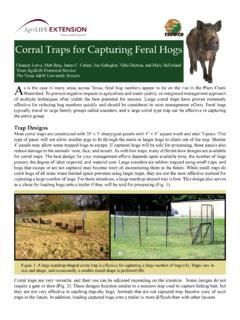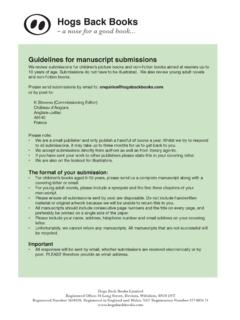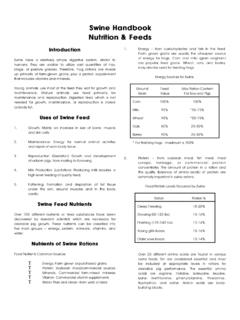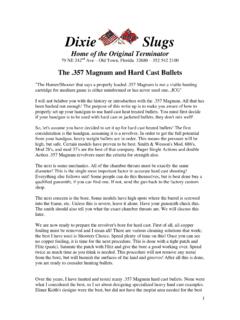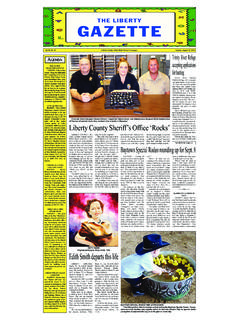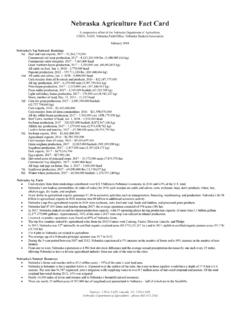Transcription of Recognizing Feral Hog Sign - Coping with Feral Hogs
1 Recognizing Feral Hog sign Chancey Lewis, Matt Berg, James C. Cathey, Jim Gallagher, Nikki Dictson, and Mark McFarland Texas AgriLife Extension Service The Texas A&M University System E xpanding Feral hog numbers represent a significant threat to agriculture and water quality in many areas of the state, including the Plum Creek Watershed. Wherever Feral hogs are found, they leave evidence, or sign , of their passing, and as Feral hog populations expand, landscape damage increases. While the most noticeable sign of Feral hog activity is damage caused by their destructive rooting behavior, it is not the only indicator of their presence.
2 In times of drought, rooting is minimal, and other signs are more common. Hog wallows, rubs, tracks, trails, droppings, and beds are all telltale signs of their presence. hogs are very mobile, and in many cases may routinely travel from one field that offers cover to another field that provides food. To increase trapping success, it is best to determine key travel corridors, which frequently include creeks, sloughs, ponds and other water sources. Understanding Feral hog behaviors and signs is central to developing management strategies to reduce their numbers.
3 A B. C D. Figure 1. Rooting damage within a bottomland hardwood forest (A and B). Feral hogs compete with native wildlife for acorns, pecans, and other mast. Feral hogs can cause damage to rural pastures and urban landscapes alike (C and D). Rooting Damage As Feral hogs feed, they severely impact native plant and animal communities, as well as agricultural crops and livestock. Extensive disturbance of vegetation and soil occurs because of rooting and may result in a localized shift in plant community composition. This can be detrimental to hay pastures, native range, lawns, and gardens alike (Fig.)
4 1). Rooting can also reduce the number of plant species in an area. Feral hog diets shift throughout the year, depending on availability of a wide variety of food items, and during periods of drought, in many cases putting them in direct competition for food with native wildlife species. Crop Damage Field crops commonly damaged by Feral hogs include rice, sorghum, wheat, corn, soybeans, peanuts, potatoes, watermelon, and cantaloupe. hogs not only directly consume planted seed, emerging seedlings, and maturing fruits and grains, but they also trample crops (Fig.
5 2). A B. Figure 2. Feral hog damage to corn (A) and sorghum (B) caused by both trampling and foraging. Wallows and Rubs During warmer months, Feral hogs create wallows in moist areas near ponds, creeks, and sloughs (Fig. 3) to access cool mud, which helps to avoid summer heat and ward off biting insects. Fecal material deposited in these locations is likely to contribute bacteria and pathogens to stream systems. In hot weather, hogs often lie in wallows during the day. After wallowing, hogs rub on fixed objects to remove dried mud, hair, and parasites.
6 Trees, fallen logs, fence posts, rocks, and utility poles are commonly used for rubbing, particularly if they are located near water or wallows. hogs have an affinity for utility poles treated with creosote, and many poles within a hog's home range will have visible markings. A. Figure 3. Wallows (A) can be found in wet areas during warmer months, and rubs are often associated with them. In areas where populations are high, Feral hog rubs frequently can be found on utility poles (B). B. Feral Hog Tracks and Trails Proper identification of Feral hog tracks and trails is very valuable in monitoring Feral hog activity and may yield information on abundance, animal size, direction of travel, and local behavior patterns.
7 Hoofed tracks generally register two toes but may also show two dewclaws, which are smaller toes found higher on the leg. Deer tracks are typically heart- or spade-shaped, while Feral hog tracks have a more rounded appearance (Fig. 4). hogs also have blunted or rounded toes in contrast to deer, and this trait is apparent in tracks they leave behind. A B. Figure 4. Round, circular shape of a Feral hog track (A). Note the dewclaw mark on the bottom left. When visible, hog dewclaws typically register wider than the hoof. Both dewclaws may not register, depending on soil and animal movement.
8 In deer tracks (B), dewclaws typically do not register wider than the C. hoof. Compare again with front and hind tracks of a Feral hog (C). Notice the round shape, blunted toes, and wide dewclaw marks. Feral hog trails can be telling. A well-worn trail indicates frequent use, and a lack of vegetation along the trail may suggest numerous hogs use the path (Fig. 5). Where trails cross under fences, hair and mud are often left on the wires as animals pass underneath. B. Figure 5. A well-traveled Feral hog trail (A). The width and lack of vegetation indicate frequent use.
9 Where hogs are active, they will often leave behind hair and mud on fences as they move through A the area (B). Feral Hog Droppings Feral hogs are omnivorous, eating both plant and animal matter, and their diet varies between areas and seasons. For these reasons, Feral hog droppings take many forms, which can make identification difficult. Droppings are often tubular, filled with mast and other vegetation, and with shape and consistency ranging from droppings resembling those of a domestic dog to those of a horse (Fig. 6). A diet of young grasses and shoots results in loose tubes and formless patties.
10 Examining droppings can reveal what hogs have been eating, which may help determine appropriate control methods or trap locations. Figure 6. The opportunistic diet of Feral hogs results in highly variable dropping shape and consistency. Feral Hog Beds Feral hogs spend significant time in beds during hotter periods of the day. They typically are found in dense vegetation comprised of vines, brambles, fallen trees, and other thick or thorny vegetation (Fig 7). In these areas, hogs create shallow beds by overturning the soil to expose the cool dirt in which they lay.
